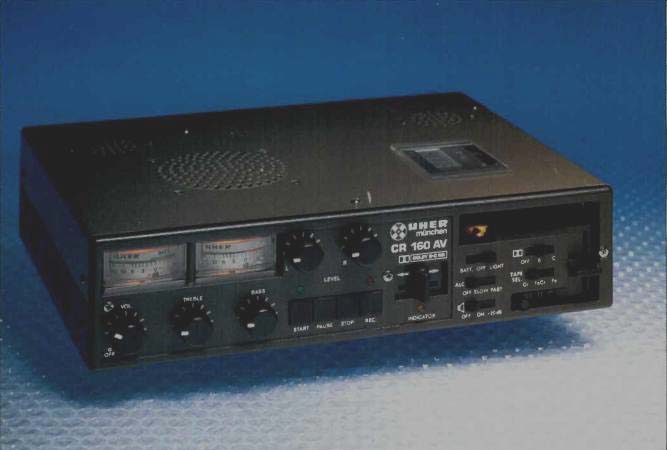
Manufacturer's Specifications:
Frequency Response: 30 Hz to 16 kHz.
Signal/Noise Ratio: 57 dBA; 73 dBA with Dolby C NR.
Separation: 45 dB.
Crosstalk: 70 dB.
Erasure: 70 dB.
Input Sensitivity: Mike, 0.35 mV; line, 30 mV; tuner, 2.5 mV; phono, 180 mV.
Output Level: Line, 775 mV; tuner, 775 mV; speaker, 3 watts/channel internal, 2 watts/channel external.
Flutter: ± 0.20% wtd. peak.
Speed Variation: ± 1.5% maximum.
Fast-Wind Time: 60 S for C-60.
Dimensions: 9 1/8 in. W x 2 1/4 in. H x 7 5/8 in. D (235 mm x 59 mm x 185 mm).
Weight: 6 lbs. (2.7 kg).
Price: $998.
Company Address: 7067 Vineland Ave., North Hollywood, Cal. 91605.
The Uher CR 160 AV portable stereo cassette recorder packs a number of important features-including provisions for synchronizing movie soundtracks-into a compact, rugged unit. As is traditional with Uher portables, it can be powered by dry batteries (C cells), a rechargeable battery, a.c. line power (from an adaptor which can be used outside the recorder or placed in the battery compartment), or, with an optional adaptor, by car batteries. Such flexibility is nearly essential in order to deal with the various conditions of remote recording.
Since portables are often used to record live sound, it's also useful to have the extra dynamic range provided by Dolby C noise reduction, as well as Dolby B NR for compatibility with other cassette decks. For additional help in dealing with the vagaries of live sound, the Uher recorder has switchable automatic level control (ALC) with a choice of time constants-fast for speech and slow for music. It is usually desirable to record without ALC, but when there's a good chance of sudden and unpredictable level increases, ALC can prevent overload and distortion from ruining an otherwise good recording.
Portables also need built-in playback monitoring facilities.
In addition to a DIN headphone jack on its side panel, the CR 160 AV has three built-in speakers-a small woofer for mono reproduction of the lower frequencies, plus separate tweeters to project the stereo image created by the upper frequencies. The bass and treble tone controls affect both the speaker and headphone outputs, but not the recording.
The CR 160 AV comes with a handy carrying case, with both hand and shoulder straps, but it is best examined out of the case. The two recording level meters are at the upper left of the front panel, with the left meter showing the acceptable battery voltage range by a green stripe above the-1 to +5 dB calibrations. Uher states that the meters are "peak reading," but confirmation of this was left for later tests. The two input-level pots, with small but well-knurled knobs, are to the right of the meters; they have medium friction, and adjustment is easy. The off position at 9 o'clock is puzzling but not annoying.
Below the meters are the playback volume, bass, and treble controls. The unit's power switch is on the volume control, and at first check it seemed to switch with too little pressure-more on this later. The tone controls added a little more puzzlement: "Treble" is on the left and "Bass" is on the right, with both giving maximum cut at 9 o'clock and maximum boost at 7 o'clock. At first, I thought the flat response setting would be straight up, but when I checked, it was at about the 3 o'clock position.
The cassette insertion slot is at the upper right of the front panel. When the tape is about three-quarters of the way in, there is some gentle spring loading; then, as its outermost edge is drawn even with the front panel, the cassette jumps into its "ready-to-play" position. A firm push down on the lever at the far right, and the tape is latched down into position for play or any other transport function. In a row under the input-level pots, from left to right, are "Start," "Pause," "Stop" and "Rec." buttons. "Start" is the same as "Play" on most decks, and it has a bright green LED above it; "Rec." has a bright red one.
Pressing "Rec." puts the CR 160 AV into record-pause mode. which is useful in setting levels; pressing "Start" begins the recording. The "Pause" button can be used to interrupt record or play, with "Start" used to resume operation. I was quite impressed by the quiet and apparently shock-free action of the solenoid, whose clunk was very soft, whether entering record from start or pause modes.
The CR 160 AV does rot allow punch-in recording, but I don't consider this too detrimental for a portable, since such machines are usually used far more for original recording than for editing.
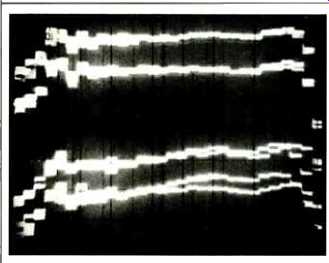
Fig. 1--Record/playback responses for two tapes, at two levels; response
with Dolby C NR is superimposed on response without NR in each case (the
upper trace of each overlapped pair is with NR). From top to bottom: Maxell
UD-XL I (Type I) at Dolby level, TDK SA (Type II) at Dolby level, Maxell
UD-XL I at 20 dB, and TDK SA at 20 dB. Note the close match between responses
with and without Dolby C NR at Dolby level, and the less close match at 20
dB. See text. (Scale: 5 dB/div.)
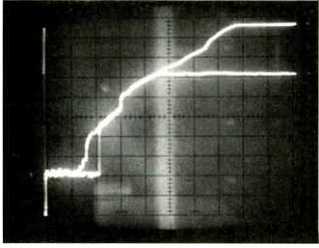
Fig. 2--Effect of a sudden increase in the level of a 1-kHz input signal,
with ALC (fast mode) and without it. Note how ALC limits the signal at 50
dB above the tape noise level, while, without ALC, the signal rises 25 dB
further. See text. (Scales: Vertical, 10 dB/div.; horizontal, 2 S/div.)
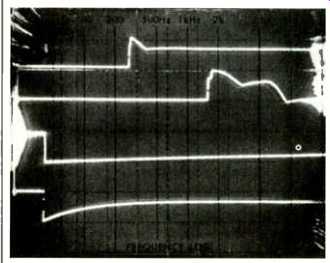
Fig. 3--Response of ALC to sudden 10-dB level changes. Upper two traces
show reaction of ALC to 10-dB rise in slow (top) and fast modes; displacement
of fast mode curve to the right is a triggering error, not a delay in ALC
action. (Scales: Horizontal, 0.1 S/ div.; vertical, 10 dB/div.) Lower two
traces show reaction of ALC to 10-dB drop in slow and fast (bottom) modes;
note the very gradual recovery rate in slow mode. See text. (Scales: Horizontal,
5 S/div.; vertical, same as upper traces.)
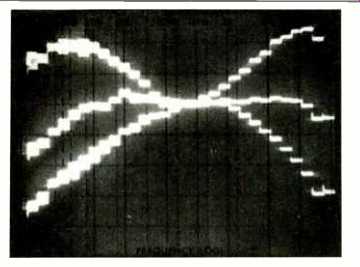
Fig. 4-Range of playback tone controls, showing maximum boost (top trace),
maximum cut (bottom trace), and "flat" (middle trace). Response
of playback speaker/ headphone amp could not be flattened further than shown.
See text. (Scale: 5 dB/div.)
Fast winding is controlled with a switch to the right of the tape-transport buttons. The switch is pushed to the left for rewinding and to Me right for fast forward. It can be pushed partway for short winds; a push all the way will make it latch for continued winding. Under it, a yellow LED illuminates during winding; it flashes during play or record modes.
To the right of the fast-wind control, and below the cassette insertion slot, are he three-digit counter (with its reset button) and five slide switches, with three positions each.
The switches for Dolby NR ("Off/B/C") and tape selection ("Cr/FeCr/Fe") are just above the counter. It was surprising to see this tape selection; FeCr ( Type Ill) tapes may still be available, but I suspect most users will not go to the trouble of seeking them out. Further, there is no provision for metal particle (Type IV) tapes, which are widely available.
To the left of these controls and the counter are switches for the battery checker and meter light, for ALC ("Off/Slow/ Fast"), and for the speakers ("Off/On/-20 dB"). Anyone who has done remote recording with a portable knows the value of the battery-status indicator, and appreciates being able to turn the meter lights on when needed and off, to save the battery, at other times. The meters also illuminate in the battery-check mode; this demonstrates good thinking on Uher's part since portables are so often used in dim light.
The speaker switch shows more good thinking. It's vital to shut off the speakers when the microphone is nearby, but useful to be able to monitor through them when the microphone is farther away. Having the option of muting the speakers by 20 dB makes it easier to control low-level monitoring. (I recently startled myself and several other people when I inadvertently switched on another portable with its speaker volume accidentally turned wide open.) The top of the recorder has three perforated speaker openings: One for a woofer, and two smaller ones, separated by several inches, for stereo tweeters. A small plastic door over the cassette compartment can be slid toward the back and removed to gain access for cleaning and demagnetizing the two heads and other elements. These tasks are fairly straightforward, but some care and attention are needed in order to clean the entire tape path properly.
Along the left side of the CR 160 AV are five sockets for connections to the outside world. The one nearest the front is the microphone input; it matches the Uher mono/stereo microphone Set M650A and other microphones with standard DIN plugs. (Microphones with other plugs can be adapted.) Further back along the side panel are sockets for "Radio/Phono" (DIN), headphones (stereo phone jack), headphones or loudspeakers (DIN), and one labeled "Access" (DIN). This last socket is for connecting accessory equipment when synchronizing sound and film via the double-track interlock method. Quoting from the CR 160 AV manual: "When recording sound by this method, synchronization of sound and picture may be achieved by controlling either the speed of the film projector (called in professional film recording 'forward control') or that of the open-reel or cassette tape recorder ('backward control')." Speed may be regulated by 1-kHz pulses that occur at every picture or every fourth picture, depending upon the system used. The Uher recorder has a special AV record/playback head, and the connections made to the "Access" socket make both forward and backward control possible.
On the back of the recorder are stereo pairs of line in/out phono jacks. There is also a DIN socket for connecting the output of a line-power source or a 12-V car battery (which requires an optional accessory adaptor.) This jack also includes stereo line outputs and start/stop switching connections for use with other accessories. Uher's manual does not specify what those accessories are, but it does say what pins these signals are on, perhaps for those who wish to build their own accessories.
The door to the battery compartment is located at the rear of the right side panel. The carefully designed space will hold six C cells, the Uher Z215 rechargeable nickel-cadmium battery, or the Z135 power supply/battery recharging unit. (Both the battery and the recharger are supplied with the recorder.) When the battery compartment is occupied by the Z215 rechargeable battery pack, the Z135 can be plugged into the back-panel socket to charge the battery or operate the recorder from the a.c. line. The Z215 can also be recharged from any source, including a car's battery, and is insensitive to overcharging or over-discharging problems which have caused many nickel-cadmium failures in other equipment I have used.
Taking off the recorder's top cover revealed the component side of the p.c. board. High-quality parts were there in abundance, including some ICs but quite a few discrete components. The cassette-loading system is simple but effective. The transport has a rugged, die-cast metal base and dual contra-rotating flywheels, and it was very quiet in play and record modes. In fast wind, it was quiet (and somewhat slow) with battery power, but rather loud (and fast) with line power. Removal of the bottom cover exposed the foil side of the p.c. board, where all of the soldering was excellent. No fuse was noted inside the recorder, but the Z135 power supply is fused.
Measurements
The playback responses of the CR 160 AV were quite good for both equalizations, with most points within ± 1.5 dB. The highest frequencies were off slightly more, and the lowest frequency for each EQ was about 3 dB down. Dolby level from a calibration tape was indicated at +0.5 dB on both meters. Tape play speed was 2.0% low, a greater deviation than desired. This would probably be noticeable by listeners with critical pitch sense if they heard tapes made on this machine played back on a deck with correct speed regulation.
Record/playback responses were checked, with and without Dolby C NR, for a number of tapes, primarily Type I and Type II. The results were quite good with many formulations but were not acceptable with either low-bias, non-premium tapes or such "hot" ones as Maxell XL I-S and TDK SA-X, which were too peaked at the high end when Dolby C NR was used. The responses were good with one of the Type Ill (ferrichrome) tapes on hand, but further testing was not performed with this unpopular tape type.
Maxell UD-XL I (Type I) and TDK SA (Type II) were chosen for use in my detailed testing, on the basis of their good record/playback responses (Fig. 1). These were measured using what I call "PN/Music," which is pink noise rolled off above 2 kHz to be more like music. In playback, I compensate for this roll-off, for flat display on an RTA. The traces shown in Fig. 1 are for response both with and without Dolby C NR. The top set of traces are at Dolby level.
They are very flat except at the frequency extremes, and the results with and without NR match each other very closely.
The bottom set of traces were made at the 20 dB level.
These show a rising high-frequency response; with Dolby C NR, this rise is almost excessive.
The response limits (the-3 dB points) obtained using test tones are listed in Table I. They show a useful increase in the high-end saturation limit with Dolby C NR. They also show the same high-frequency limits at the-20 dB level for both Type I and Type II tapes, both with and without Dolby C NR; I suspect this means a multiplex filter is always on.
Table II lists a number of measured record/playback characteristics. The results are all very good. Note that I measured erasure, as I usually do, at 100 Hz, obtaining a figure of 72 dB; at 1 kHz, the frequency for which Uher specifies erasure, I measured well over 80 dB, considerably better than the manufacturer's specification. Bias in the output during recording was very low.
Table Ill lists third-harmonic distortion for both tapes, using Dolby C NR. Measurements were made over a range of levels, starting at 10 dB below Dolby level, with the input increasing until the 3% distortion point was reached. With Maxell UD-XL I, there was less distortion at 0 dB, together with a higher maximum recorded level, but at the lowest levels, distortion was much lower with TDK SA, the Type II tape. Second-harmonic distortion (HDL2) was high for both tapes at all recorded levels. At the lowest levels, HDL2 was several times higher than HDL3, but at the higher levels HDL3 was predominant, fortunately; otherwise, the maximum recording level would have been lower. Table IV shows HDL3 versus frequency from 50 Hz to 4 kHz at-10 dB below Dolby level, on TDK SA, using Dolby C NR. These figures are all excellent, but the applause must be muted because of HDL2, which was a minimum of 0.36% at 400 Hz, 0.67% at 50 Hz, and 1.0% at 2 and 4 kHz. The record/ playback head was demagnetized four times during the testing, but there was no reduction in the level of HDL2.
Signal-to-noise ratios were measured for both tapes, with and without Dolby C NR, using both IEC A and CCIR/ARM weightings. The results in Table V are very good, but the numbers obtained with Dolby C NR are not a match for those I've obtained with a number of other decks. This is quite consistent with the fact that the level at which the Uher reached the 3% distortion limit was not terribly high.
Table VI presents input and output characteristics measured at kHz. The headphone output level was very high and could generate more than very high sound levels with all of the headphones tried. The 1.42-V line-input overload point will not be a problem in most cases, but it is low enough for the input to possibly clip when fed the full output of some equipment (such as CD players). DIN-socket input and output levels were checked, and were all found to be in accordance with specifications.
Next I took a look at the ALC circuit. To check its action and threshold on a signal with slowly increasing level, I manually increased the level of a 1-kHz tone while recording from the beginning of a cassette. Figure 2 shows that the limiting threshold was reached at 50 dB above the tape noise, and that there was no change in the recorded level as I further increased input level over a range of more than 25 dB. Figure 3 shows how the ALC's slow and fast modes differ in their response to sudden 10-dB level changes. Note that the initial response time to a fast 10-dB rise is very nearly the same in both modes (ignore the fast-mode trace's displacement to the right, and compare the shapes of the two traces). With a fast 10-dB decrease, however, it is obvious that the recovery time in the slow mode is much longer than in the fast one. Do not confuse this ALC circuit with the type found on inexpensive recorders. The chief difference (aside from its two-speed operation, which even some inexpensive models have) is that the Uher's ALC works only on signals above a threshold level. As a result, it does not fill pauses in the program material with background noise that has been suddenly raised by the ALC to full program level.
The level meters reached close to full response with a tone burst of 100-mS duration, and the decay time was 450 mS; the meters might be classified as "fast responding," but not "peak reading" as Uher states. Meter scale calibrations were very accurate over their entire range, among the best I've measured. In recording, the meters measure the signal after it is equalized, a common practice on European recorders. I much prefer this post-EQ metering, as it measures the signal actually being fed to the tape, and gives better warning against tape saturation. Measured meter responses in recording, therefore, were up by 4.5 dB at 28.5 Hz, were flat from 250 Hz to 3 kHz, then rose to +6 dB at 8.5 kHz and reached a maximum of + 11 dB at 14.8 kHz before sharply dropping off.
The bass and treble controls usefully improved the monitored sound, both through headphones and over the built-in speakers. Figure 4 shows the range of these controls. Note that flat response could not be obtained through the speaker/headphone amp (which does not, of course, affect the recording or the line outputs). Trying to flatten the middle curve in Fig. 4 by boosting bass or treble, which would bring the frequency extremes back up to zero level, would have caused undesired boosts at the bottom and top of the midrange.
Flutter was a satisfactorily low 0.09% wtd. rms and ±0.15% wtd. peak, consistently from one end of a C-90 cassette to the other. (There was, however, a slow, random speed variation of ±0.1%.) I gave the Uher a vigorous shake-and-movement test, including rotations around all three axes, but there was no effect on flutter or speed.
Changing line voltage did affect speed slightly: It increased 0.1% when the line voltage was reduced to 110 V and decreased by the same amount at 130 V. With line power and a C-60 tape, the fast-wind time was 60 S, faster than most decks. All changes in mode were accomplished in about 1 S, even if initiated manually.
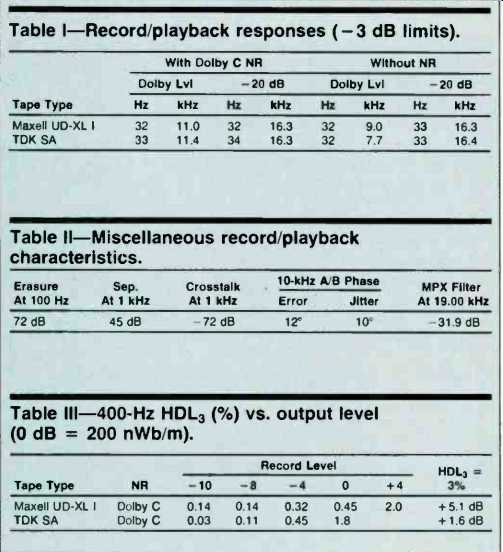
Table I--Record/playback responses (-3 dB limits).
Table II--Miscellaneous record/playback characteristics.
Table III--400-Hz HDL3 (%) vs. output level (0 dB = 200 nWb/m).
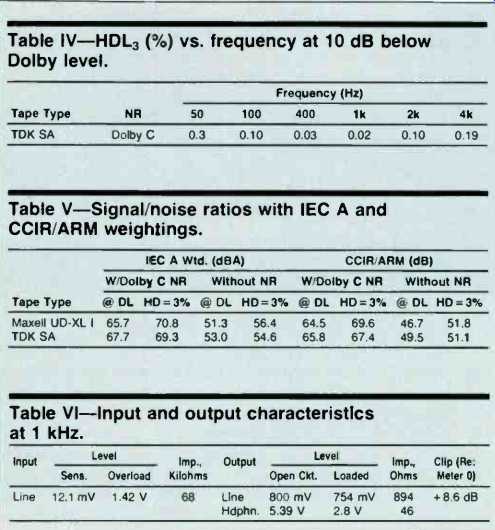
Table IV--HDL3 (%) vs. frequency at 10 dB below Dolby level.
Table V--Signal/noise ratios with IEC A and CCIR/ARM weightings.
Table VI--Input and output characteristics at 1 kHz.
Use and Listening Tests
The owner's manual presents considerable detail with excellent instructions on powering and connections. The ALC guidelines were incomplete in that there were no statements on the meter indications that one could expect--it is possible to overdrive the input while ALC keeps meter indications from being excessive. An excellent schematic is provided, along with a board layout and basic service and alignment instructions--quite valuable to the careful user.
All controls and functions were completely reliable during the testing. I did feel that too little force was needed on the volume control to turn the unit off, and I missed having a counter memory. Just about everything else became quite natural with use. The record click was small, there was hardly a sound from "Pause," and "Stop" got a double click, all just above the tape noise level with Dolby C NR. For my listening tests, I recorded a number of LPs, most of them dbx-encoded, played through a dbx decoder to obtain a signal of wide dynamic range. The sound of the piano was really very good on Chaminade's "Concertstück for Piano and Orchestra," with James Johnson, pianist, and Paul Freeman conducting the Royal Philharmonic Orchestra (Orion ORS78296, dbx GS-2005), even while I moved the CR 160 AV in many different ways. This, more than anything else, convinced me of the excellence of Uher's contra rotating-flywheel drive system. To check the ALC function, I recorded Baroque Brass by the Empire Brass Quintet (Sine Qua Non SQN-SA2014, dbx SS-3001), constantly increasing the input level and switching the ALC on and off every few seconds. As the level rose, the improvement made by the ALC was emphatically obvious, turning the sound from horrendously overloaded to quite good.
I spent some time listening to sound from the built-in speakers. Although there was not what one would call a broad stereo image at 2 or 3 feet, the great improvement in the detailing was very apparent when comparison was made to a monaural version. The tone controls were a definite contributor to the quality of sound during this listening. A headphone check showed that there was a slight increase in noise level with Dolby C NR, in comparison with the dbx-encoded original, but it was usually not detectable. The Uher CR 160 AV offers at least very good performance in most areas, with the puzzling exception of the relatively high second-harmonic distortion. Such distortion is notorious for being caused by leaky coupling capacitors, and so may be due to such a defect in my sample, and not typical of the model, I trust. The CR 160 AV has great flexibility in powering and for synchronization with film systems. Its price is high, compared to typical cassette recorders, but it is not a typical machine. The unique combination it offers may very well make for a good investment.
-Howard A. Roberson
(Source: Audio magazine, Jan. 1986)
Also see:
ASC AS-6004/S Open-Reel Recorder (Jan. 1984)
= = = =